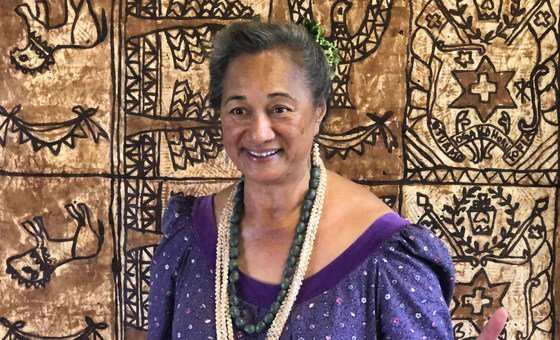UN News spoke to Ms. Kauka as part of the International Labour Organization’s photography project “Dignity at Work: The American Experience” ahead of International Day of the World’s Indigenous Peoples which is marked annually on 9 August.
“I have been teaching my students how to produce kapa which is a traditional cloth made from the inner bark of a native plant. This material is used for clothes for both men and women, and for blankets, as there was no woven or loomed clothing in the past.
Traditional designs are printed onto the cloth using natural dyes. In the winter people would wear several layers of kapa which they would gradually peel off as the weather got warmer. It is also used in ceremonies. I was recently asked to make a kapa to wrap and then inter ancestral remains, the bones of our ancestors, that were returned home to the islands as a result of federal legislation in the Native American Graves Repatriation and Protection Act (NAGPRA).
My students have learned how to grow and then harvest the plant, remove and clean the bark with a shell, and how to prepare by pounding it with a wooden mallet called a hohoa. On one side of the hohoa is a carving which is used to print a design on the cloth. This imprint with inks tells stories of our culture. A hands-on approach is key to learning these indigenous crafts and is an important part of the process of transferring knowledge to the next generation.
I am passionate in wanting my students to know about Hawaii and, by knowing this place, I hope that they will feel a responsibility to take care of it: both the physical beauty of the islands but also the cultural traditions that I teach here, including music, art, dance and crafts.
COVID-19 and sharing

Wooden hohoa are used to flatten and then imprint kapa cloth.
The school year was cut short by COVID-19, so my students were not able to finish making the kapa, although some will be able to do so in summer school classes.
The lockdown has been traumatic for me, as I am so used to hands-on working, and interacting with the students, and it took some time for me to create new online lessons. I found the technology challenging, but I received great help from high school students and my grandson.
I think COVID-19 has pushed people in Hawaii to recognize the importance of heritage. People are not rushing around as much under lockdown and so they are more appreciative of their surroundings; the sea, the water from our hills, the landscape.
The pandemic has enabled people to really feel the spirit of nature, it is connecting us to the land, and it is teaching young people about the importance of sharing. People around me have less money because of the lockdown but are sharing more.
I have felt such joy to receive gifts of fresh vegetables and fish brought by students and friends.
This is really the essence of native Hawaiian culture is aloha aina; the love of the land and the love of the people. The land is the chief and the people are the servants.
I always tell my students that wealth is measured in different ways; wealth is not just to be found in money. Wealth is in food, wealth is in family, wealth is in friends, wealth is in nature and indigenous knowledge. So, people can be very wealthy in all those ways, but have a very small bank account.
Climate Change
Hawaiian indigenous culture is inextricably linked to the land and the island ecosystem. Climate change is now significantly affecting that ecosystem. Sea levels are increasing, and the ocean is warming, affecting our coastal habitats including coral which, according to our legends, is where life began. We have also seen marine debris, including plastics, which have been carried by currents across the North Pacific from Asia.
Changes are taking place in our forests as native plants struggle to survive and our watersheds suffer. Every native plant has an important role to play in our ecosystem.
There’s great awareness on this island for the health of the land, sea, and air, and how they can best be protected: these are messages that are part of the Hawaiian culture that I’m teaching.”

